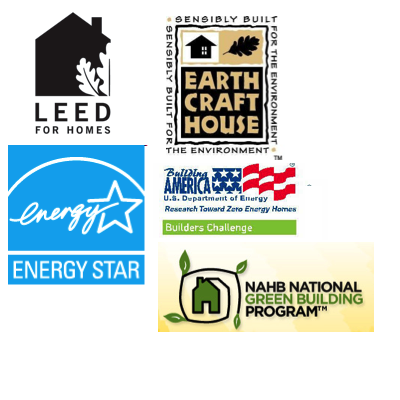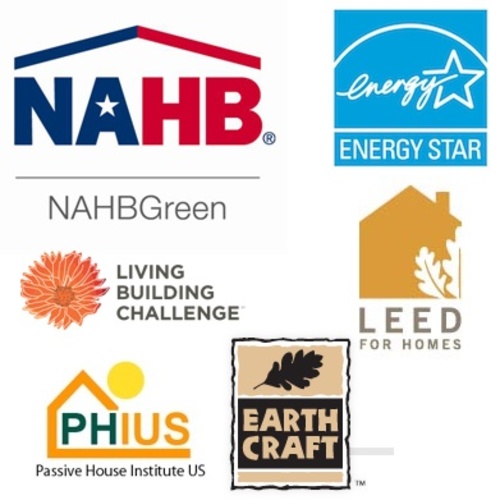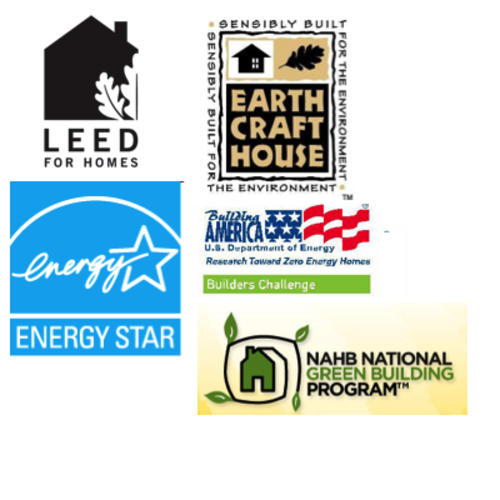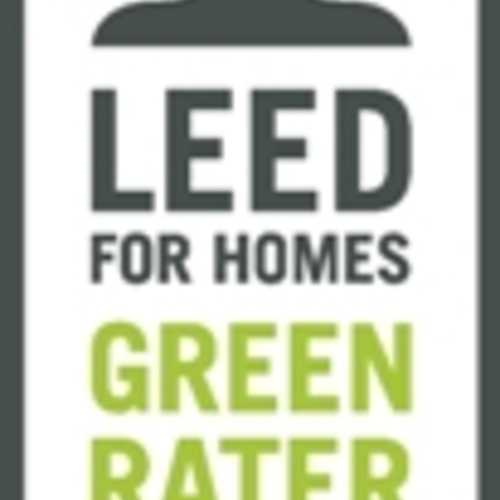
Following up on my recent post about LEED and other green programs, it occurs to me that the people responsible for creating and managing most green home certification programs have completely missed the big picture. I hope and believe that one day, through a combination of more stringent codes, legislation, and marketplace demands, we will reach a point where green building becomes the minimum acceptable standard. I recognize that we have a long way to go to reach this goal, and I don’t expect us to get there any time soon.
In the meantime, I think that third-party certification by one of the many available green home programs is the best hope for industry transformation. While demand for these certifications is increasing, many builders and homeowners don’t see the value in the extra costs involved in getting the certification. I frequently hear from contractors that they build or renovate to a particular green standard, but don’t bother to get the testing or certification. Most homeowners are not savvy enough to recognize that without effective third-party oversight, they may not be getting what they expect. Then again, they may not expect anything.
Look at who’s doing it right
I have the most respect for the contractors who don’t see it as a burden or worry about the extra cost. Rather, they view it as an important part of their overall business strategy. Michael Chandler put it nicely in a follow-up comment to one of his recent posts: “I never ask my customers to pay for certifications any more than I would put a line item in their budget for a newspaper ad I plan to run. It’s a marketing differentiator.” This is the right attitude to take regarding certification. It should not be project specific; it needs to be an integral part of your business. The most successful green contractors are those that don’t offer green as an option; they just do it all the time because they know it’s right.
Can’t we all just get along?
Good green programs work hard to avoid “greenwashing” through rigorous requirements and independent verification of completed projects. Programs continue to raise the bar on performance, which, while good in theory, in many cases increases the complexity and cost of certification, without necessarily producing higher-performing buildings. There are many excellent builders out there who are very capable of creating high-performance homes who don’t have the time or the particular skill set to assemble the required documents for certification. Not providing them with an appropriate entry point to building certification equals lost opportunities. It doesn’t mean they aren’t capable of doing a good job, just that they can’t fit a particular program’s image of a green builder.
I believe it is possible to create a meaningful, manageable, accessible, and reasonably priced green home certification, something few if any of the existing programs now accomplish. Programs such as LEED and NAHB have so much invested in their programs that they can’t see outside their own boxes enough to make the substantial changes they need. Local programs, many run by nonprofits, don’t have the resources to reinvent themselves, particularly in the current weak construction market.
It seems to me that if we could just pool everyone’s resources and put together one great green program, we would all be a lot better off. I’m not so optimistic to believe that this can actually happen; it’s just wishful thinking.
Weekly Newsletter
Get building science and energy efficiency advice, plus special offers, in your inbox.















10 Comments
Green Certifications
Well said. We certify all of our homes. Originally we charged for the certification, mainly because it was an unknown. Now, it's just who we are. It would be helpful if one day there was a more standardized approach. There are so many certifications....have to pick the "certification du jour" for each job. For us, it's just how we build houses.
Green: Reality Meets Ideals
Wow! The subject of green building programs and their deficiencies
seems to be on everybodys mind lately. Michael Anschel wrote a good piece in his blog not too long ago. I was so impressed with it that I reprinted it and added my own commentary on my blog.
I agree that a unified green building assessment standard would be a boon. Unfortunately, what I think we're more likely to get is a green building code. In fact, the International Code Counsel (ICC) has already released one, as has the State of California. But these are codes, not assessment or rating standards. Even the "Home Energy Rating System" (HERS) is not a rating standard, but a set of technical requirements on which various rating systems are built.
And there in, as you point out, lies one of the problems: Every system uses a different assessment method that produces different results that produce varying degrees of accuracy. LEED is gaining quite a reputation for it's "gold" and "platinum" buildings not performing the way their assessment system says it should perform. As a green design/builder I find that frustrating. Do I design and build to their standard to please folks like you who "have the most respect for the contractors who don't see it as a burden or worry about the extra cost. Rather, they view it as an important part of their overall business strategy," or to my own, so that I know that the building will perform the way the customer wants it to perform?
I also have to take issue with the whole "I'm going to use a 3rd party rater and eat the cost whether you like it or not" approach as being a good "overall business strategy." For one thing, I doubt very much if Mr. Chandler or Ms. Fransik are really not including the cost of the rating system in either their cost estimates or as part of there overall business overhead. No business stays in business for very long that shrugs off real costs -- especially something as expensive as the fees most of these raters charge.
For another, while shoving a 3rd party rating down a customer's throat might be a winning business strategy where you live, it's certainly not where I do business. Every customer has their own ideas about what's green and what's not; what is sustainable and what is not; what they can afford and what they can't afford; and if I want their business, I'd better listen or they'll go elsewhere. They may want LEED, they may want California Green, they may want Energy Star, they may prefer my own system; they probably will have to compromise to make the project fit into their budget.
Ideals are a great thing. They're what we all strive for. Rarely do they fit seamlessly into reality.
Michael at Alternative Building Services
3rd Parties
I must have missed the first and second ones. In any case, I wasn't suggesting that anyone has to have their homes specifically certified to LEED, NAHB, ENERGY STAR or a particular local program. What I am suggesting is that (almost) anyone who wants to build or renovate a home sustainably needs to have a third party look over the work and provide independent verification that it meets whatever bar the builder has set. As I have said in previous posts, building green doesn't cost more if you meet the building code, the energy code, manufacturer's instructions, and competent field practices. it does cost more than building crap (not to suggest that either of you do), but we need to get away from accepting crap as the standard.
If we can accept that the hard costs are not much, if any more to build green, then we get to the certification costs. Michael Chandler puts it right - it is part of his marketing. You might put it somewhere else. You might even build it into your job cost and if you do, all power to you. Just don't offer it as an option. If you build a very high performance house you might even get the $2000 federal tax credit (if it gets renewed), which should more than pay for the certification fees.
If you build green, and include some level of inspections and certification, and you have a client who wants to go further, feel free to charge them any costs over your standard to get there. But if you give your client an option to be certified green, chances are they won't take it, and you will be missing a marketing and PR opportunity along with some good quality control to make sure your team is working to their best.
Would you...
Building without Building Science.....I don't have a pilots license but I can still probably fly an airplane. We probably wont crash and burn. Right?
Building might not be as life threatening but it is usually a good thing to have some kind of training and certification so folks know that you actually know what you are doing. It seems we have been relying on building codes and laws instead of education about how things actually work. Bigger, cheaper, faster type of construction is catching some heat when we find out later those 'codes' can actually cause safety issues down the line.... all because nobody looked at the building as a system.
Who's flying your house?
third party certification
I have been certifying our homes under Energy Star and a regional built green program for several years and have never given my clients the choice in the matter. Since nearly all of our clients select us because of what we do, I don't have to sell them on certification, and the costs are a line item in their budget. If I believe it's important and they believe in me, it's not an issue. While some may see certification as a marketing tool, I have found it to be more valuable as an educational tool. Testing, the central point in certification, provides the means by which a builder can continue to improve on the critical details that move the empirical knowledge base forward. I expect every house to test out better than the last. If it doesn't, we have failed our client.
The View from One of the Local Green Building Programs
As an architect and the technical writer of the residential green building program in San Antonio, I was well aware of the issues addressed in Carl's blog and in some of the commentary. Keeping in mind that our program is being administered by a non-profit funded by the city, county, electric utility, and water utility, funding issues pressure us to rely on certification costs as an ever increasing percentage of keeping the program operational as the number of annual certifications rose. Those forces, as the funding partners begin to whittle away funding for the program during the current economic crisis, tempt the director of the program to ease-up on the requirements needed for certification. The temptation was resisted and in my opinion, the 2010 criteria for certification (at four different levels for new construction and currently two different levels for retrofit certification) is meaningful and does not fall into the category of "greenwashing."
Our focus has always been on providing a certification pathway for the entry-level and subsidized housing market (as well as middle and upper income markets) which adds another dimension driving the costs of certification low. Requiring each home to earn an ENERGY STAR certificate reflects a larger percentage of construction cost for an affordable home. Program certification costs remain considerably lower than the cost of an independent ENERGY STAR provider for this category of home. These are all serious elements to balance as any local green building program navigates between credibility and keeping the doors open. I've already stepped aside from salaried employment to part-time consultant, and the Director and I both look for the day in the near future when the codes are improved to the point that the green building program will not be necessary. This is already starting to happen. We increased the program requirements in 2010 when it became apparent that the 2009 IRC just adopted was close to our entry-level criteria while operating under the 2006 IRC. Now that the builders are increasingly recognizing the benefits (and ease) of earning ENERGY STAR certifications, the next challenge will be whether there will be enough RESNET raters available to handle the volume as the recovery gets underway.
Tax credit for certification
Interesting discussion. Perhaps we are in the transition from third party programs to code, but I do think that it will have a lot to do with how lofty the goals of the program actually are. If its a band aide, its an easy code adoption. No disrespect meant to the code officials. Its a highly politicized process and not easy to change. My impression is that codes will always follow the "deep green thinkers" (safely in the distance). That's a round about way of saying that the third party groups will always push ahead while the code will distantly follow. Based on that, I'm still a big fan of third party certification. They continue to bring the idea's and performance improvements. The model that I like is a tax credit for the deeper than "ankle depth" green programs. Especially as it relates to energy. There is, and will continue to be, money available for promoting and improving energy conservation. Marginal improvements don't justify significant credits, but quantum improvements do.
I'm happy to say that we can look to Oregon to point the way: One member of Passive House Northwest just finished an Oregon Passive House (neck deep green) and found that Oregon DOE has a tax credit program in place that rewarded $4000 for the shell improvement made to reach Passive House requirements. The requirement to receive the tax credit was the 3rd party certification by Passive House Institute. For this project in Oregon, the cost of certification actually returned a profit to offset the cost of improvement to reach Passive House levels (currently tagged at 7 to 10% by our area Passive House Northwest Members). It's interesting to note that a LEEDS certification can also earn the tax credit.
My view is that the current opportunities for third party programs and Green Building overall is to bring a quantum change in energy efficiency to a project. The topic for the next 20 years will be largely about energy. If the new programs can deliver substantial reductions of energy consumption, those savings will provide the revenue to offer tax credits for certification that the projects are meeting their stated goals. Hopefully our industry can continue to make the case to local and national officials that: going forward we are able to build in ways that will greatly reduce project reliance on energy consumption in the collection of building materials, site work, and finally the lifetime energy requirement of the project itself. The national savings by this approach will more than offset the costs of a tax credit for verification. And again... it's the "deep green" programs that can deliver the results to make it possible.
Really?
More stringent codes and "green" building as a minimum? LOL Why don't you move into a 400sqft straw bale home and lead by example? Or how about you tell my grandparents who barely even use an A/C or heater to blow a bunch of money on a 22 SEER? You are the problem with "green" building today. Green is a teepee and living off of the land, you are typing on a chinese keyboard staring at a chinese monitor with video from a chinese computer with a home much bigger than you need talking about what others should do. How about you live green and leave the rest of us alone like an Amercian should, another socialist brainwashed by the huge amount of time you spend watching your chinese made TV. How about you move to a climate that requires little heating and cooling, or just use blankest in the winter and sweat in the summer? All the people here are the same, took a one week gubment chrony BPI, LEED, OR HERS OR USGBC class and now they think they know something. Any of you build dozens of homes per year for half your life? If I were to build and efficient house, why in the hell would I waste the customer's money which is usually borrowed, to have some government chrony come in and put a sticker on it? When the customer has low energy bills like they all do, they tell other people. If you make efficiency upgrades that don't perform at a rate higher than their mortgage rate, they lose money every year to a bank, if any of you would actually do some research, building beyond most codes will not return better than a 6% mortgage. Should people building a 2 million SQFT home with a hot tub and two pools really give a crap about energy? I am going to laugh my butt off when they finally create a super cheap "green" way to produce energy, and all of you chronies lose your jobs. Ever think about how much easier it would be to fix energy "creation" than fix each individual home? Nahhhh, your chronies! You don't think much at all.
Tax credits are free, I was told so!
Thats great all of you typing away about tax credits, rebates, incentives (all deceptive words that are closer in definition to WELFARE) I choose to live conservatively, I chose to make my home efficient, I choose to struggle a bit with comfort and keep away from the thermostat, and now I am going to cover the cost of some A-holes passive-hause and you think this is great! Get your socialist heads out of the dirt, this money isn't free, and if I choose to live "green" should I have my hands out for your money so that we can just fly right by our debt limit? The "green" movement if any of you had any sense, is driven by, promoted by, run by, and loved by...........BANKS! Guess who wins the most when you build "green". It is less the color of efficiency, more the color of money.
Response to Greg Hecker
Greg,
But tell me, Greg -- how do you feel about government incentives? I'm not sure I know how you feel yet.
Seriously, Greg, if you slow down, catch a breath, and read a few articles on GBA, you'll realize that many writers here agree with you that huge homes don't deserve a green label; that small homes are better than big homes; that simple lifestyles are better than gadget-filled lifestyles; and that the greenest approach to home building often means -- don't build anything at all, but be satisfied with what you've got.
Others (including me) have written articles pointing out that many government incentive programs are ill-advised or even counter-productive.
Log in or create an account to post a comment.
Sign up Log in